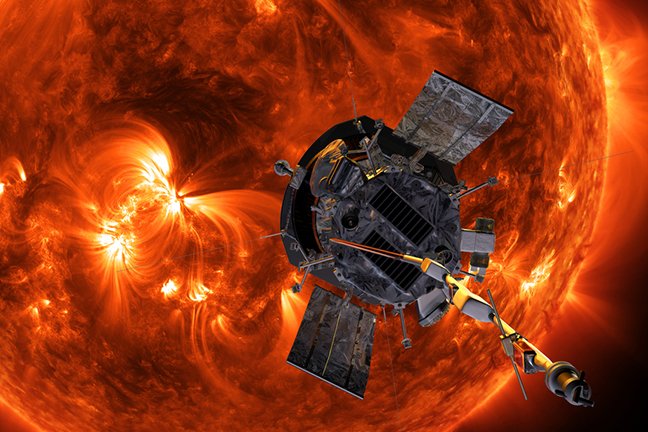Touching the face of the sun

Above: This illustration of the Parker Solar Probe shows it approaching the Sun. Credit: NASA/Johns Hopkins APL/Steve Gribben
CSE physicists and alumnus are part of a NASA solar mission
August 14, 2018
Swooping closer to the sun than any previous mission, a new NASA spacecraft will probe the star’s corona—and its two biggest secrets—with help from University of Minnesota space physicists.
The University of Minnesota researchers, along with colleagues at other institutions, including University of Minnesota College of Science and Engineering alumnus Stuart Bale (M.S. Physics '92, Ph.D. '94), make up one of four teams chosen to design experiments for the Parker Solar Probe that launched in August 2018.
“It’s a dream mission,” said physicist Keith Goetz, principal investigator for the University of Minnesota’s Parker Solar Probe team. “It’s the most interesting thing in space physics. Understanding how nature works is our big thing in physics, but so is understanding how the world around us works.”
For example, the Parker Solar Probe will have a front row seat at the genesis of the solar wind—a constant, 3-D torrent of subatomic particles streaming from the sun’s corona (atmosphere) at up to a million miles per hour. When pointed at Earth, its most energetic outbursts endanger power grids and astronauts. By revealing the underpinnings of the solar wind, the Parker Solar Probe will make it easier to predict and take precautions against its strongest gales.
NASA named the probe for solar physicist Eugene Newman Parker, who, among other revolutionary contributions, predicted the discovery of the solar wind.
Like 500 suns
The Parker Solar Probe is designed to be the fastest vehicle ever built.
The size of a small car, the spacecraft will perform seven flybys of Venus, tapping the planet’s gravity to steer itself ever nearer to the sun. At its closest, it will sail through the corona at speeds topping 400,000 miles per hour, fast enough to get from New York to Tokyo in less than a minute.
At closest approach, the Parker Solar Probe will plunge within four million miles of the sun’s core—eight times closer than Mercury. As NASA puts it, if the Earth and the sun were at opposite goal lines on a football field, the Parker Solar Probe would reach the sun’s four-yard line. The closest any previous spacecraft has come is the 29-yard line.
“It’s one of the most challenging missions NASA has ever tried to do,” said Parker Solar Probe team member John Wygant, a physics professor in the College of Science and Engineering.
“The spacecraft’s heat shield has to withstand temperatures as high as 2,550 degrees Fahrenheit,” Wygant noted.
That, said Goetz, is what it would be like on a beach under 500 suns—hot enough to melt steel.
Solving the mysteries
The experiments aboard the Parker Solar Probe will address two mysteries that have fascinated physicists for five decades.
First, with the sun’s surface temperature hovering around 10,000 F, subatomic particles that escape to the corona ought to cool off en route. Instead, they are heated to a few million degrees—more than 100 times hotter. Thus, some mechanism must exist to transfer energy to the corona, where it is dissipated as heat.
“Whatever heats the corona has to be electric and magnetic fields. That’s all there is,” said Goetz. “There are competing ideas about the details, but no measurements or observations.”
The second enigma concerns the solar wind. A hidden dynamo in the corona must accelerate the particles to their otherworldly speeds. Again, electric and magnetic fields are implicated.
“The Parker Solar Probe lets us finally make the measurements we need to settle the debate about coronal heating and understand why the solar wind is so fast,” Goetz said.
A FIELDS day for physics
The U’s role centers on the time domain sampler, or TDS, an instrument Goetz designed to measure electric and magnetic fields, radio waves, and abundances and sizes of interplanetary dust particles. This souped-up car radio, as he calls it, also periodically sifts its stored data and saves only what seems most promising or intriguing.
The TDS work is part of FIELDS, one of four sets of scientific instruments aboard the Parker Solar Probe.
Other U FIELDS members are physics professor Cynthia Cattell and retired physics professor Paul J. Kellogg. The principal investigator for FIELDS is College of Science and Engineering alumnus Stuart Bale, currently a University of California Berkeley physics professor. He earned bachelor’s degrees in physics and math in 1989, and a Ph.D. in physics in 1994 from the University of Minnesota.
“I think this mission will be epochal. The solar corona is one of the most important places in the solar system we’ve never visited,” Bale said.
“Also,” he noted, “as happens whenever we develop cutting-edge instrumentation and send it into space, I expect we’ll have a few exciting surprises.”
Story by Deane Morrison
If you’d like to support innovations at the University of Minnesota College of Science and Engineering, visit our CSE Giving website.
